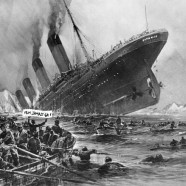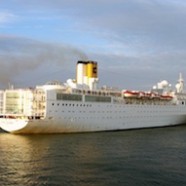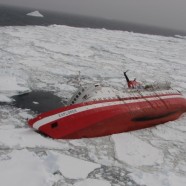Stop the Gigantics !
Costa Concordia – Press release n°3
Giglio
The Gigantic was the name with which White Star Line christened its 3rd liner. The Gigantic was even bigger than the Titanic.
After the Titanic sank, the company changed its communications strategy, launching the Gigantic under the name Britannic in 1914.
Somewhere between ‘Are you ready?” and “shhh!…The child’s asleep”.
The maritime prefect of the Mediterranean has chosen the right option: the first. They have deployed anti-pollution measures in Corsica to counter the possible arrival of oil from the Costa Concordia wreck. Italy has yet to do the same for Sardinia and the Elba. It is noted here and there that there are recommendations on the use of dispersants. In an environment as fragile and rich in biodiversity, this toxins product is not recommended.
Faced with soothing words from several stakeholders, Robin des Bois emphasises that pollutants and floating debris in the marine sub-region encircled by Italy and France can float hundreds of kilometres.
Costa Concordia : the worst has been avoided
Gigantic ocean liners and other types of ships such as container ships have worried towing and sea salvage specialists for years. Such large vessels worried the sailor and writer Joseph Conrad a century ago. Back in May 1912, one month after the Titanic tragedy, , he imagined the horrors and doubts of a night-watchman in the future, that is to say today. “ You are at night on the bridge in charge of a 150,000 tons ship, with a motor track, organ-loft etc. with a full cargo of passengers, a full crew of 1,500 cafe waiters, two sailors and a boy and three collapsible boats (.). You perceive suddenly right ahead, and close to, something that looks like a large ice-floe. What do you do? “(1).
Life jacket for the French Ambassador in the Arctic
Once more, he could not say no to the invitation of a ship owner with a polar cruise. Michel Rocard, French ambassador for the Arctic and Antarctic poles embarks September 4th from Iqaluit in the Canadian arctic for eleven days aboard the Boréal.
This voyage is not without risks for the passengers and the environment. A year ago exactly, in the same waters, the Clipper Adventurer ran aground on a reef. The 197 passengers and crew members had to wait forty-eight hours on the ship, in distress, before beginning to be evacuated. Means of assistance and salvage from Canada like other coastal states of the icy Arctic Ocean are inadequate. The ship owner sued the Canadian government for mistakes in the mapping surveys. Today, only ten percent of the Arctic Ocean is correctly charted.
A new contaminated site in Arctic ? (*)
Since Friday 27th August, the Arctic Ocean is threatened by the Clipper Adventurer. This ferry converted into a cruise ship was built in 1975 in ex-Yugoslavia. She is flying the Bahamian flag. She ran aground a reef along the Nunavut shoreline. Salvage operations are considered.
The state of Bahamas has not signed the MARPOL annex IV on the prevention of pollution by sewage from ships. The owner is based in Miami.
This warning incident demonstrates that all nautical and juridical precautionary measures are not implemented to avoid pollution in the Arctic Ocean.













